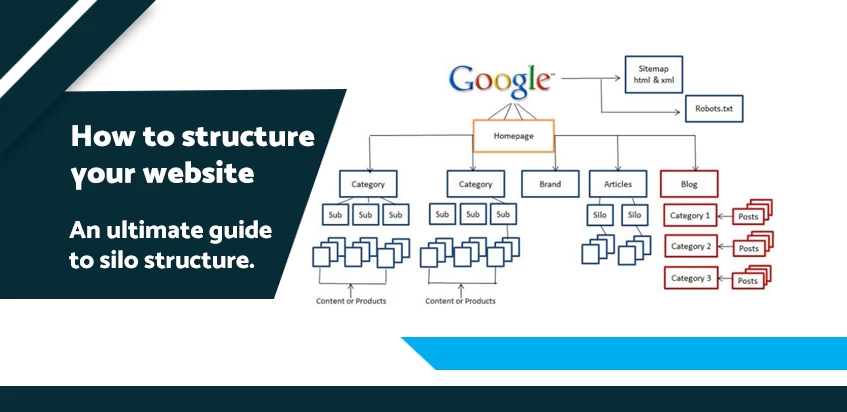
What is Silo Structure?
A silo structure is a way of organizing a website’s content in a way that helps search engines understand the relationship between different pages on the site. This can improve the site’s search engine rankings and make it easier for users to find the information they are looking for.
In a silo structure, the main topics or themes of a website are organized into “silos” or categories. Each silo contains pages related to that topic, and the silos are organized into a hierarchy with the most important topics at the top.
Internal linking is used to link between pages within the same silo and to link from the main silo pages to subtopic pages. This helps search engines understand the relationship between different pages on the site and makes it easier for users to navigate the site.
Overall, a silo structure helps improve a website’s search engine rankings and makes it easier for users to find the information they are looking for.
Why Silo Structure?
A silo structure can improve a website’s search engine optimization (SEO) by helping search engines understand the relationship between different pages on the site. This can improve the site’s search engine rankings and make it easier for users to find the information they are looking for.
When a website has a clear silo structure, search engines can easily crawl the site and understand the content of each page. This allows them to properly index the pages and display them in relevant search results.
A silo structure also makes it easier for users to navigate a website and find the information they are looking for. This can improve the user experience on the site, which is a factor that search engines consider when ranking websites.
Overall, implementing a silo structure on a website can help improve its search engine rankings and make it more user-friendly.
Benefits of Silo Structure
There are several benefits to using a silo structure on a website, including:
Improved search engine rankings: A silo structure can help search engines understand the relationship between different pages on a website, which can improve the site’s search engine rankings.
Better user experience: A silo structure makes it easier for users to find the information they are looking for on a website, which can improve the user experience on the site.
Improved internal linking: A silo structure provides a framework for organizing a website’s internal linking, which can help search engines crawl the site and understand its content.
Better organization: A silo structure helps to organize a website’s content into logical categories, making it easier for users to find the information they are looking for.
Overall, a silo structure can help improve a website’s search engine rankings and make it more user-friendly.
Types of Silo Structure & How to Implement them
There are several different types of silo structures that can be implemented on a website, including:
Topic-based silos: In this type of silo structure, the main topics or themes of a website are organized into silos. Each silo contains pages related to that topic, and the silos are organized into a hierarchy with the most important topics at the top.
Product-based silos: In this type of silo structure, a website’s products are organized into silos based on the categories or types of products. For example, a website selling clothing might have silos for men’s clothing, women’s clothing, and children’s clothing.
Location-based silos: In this type of silo structure, a website’s content is organized into silos based on geographic location. This can be useful for websites that have different content for different regions or that have physical locations in multiple locations.
To implement a silo structure on a website, follow these steps:
Start by identifying the main topics or themes of your website. These will become the main categories or “silos” of your website.
Create a hierarchy for your silos, with the most important topics at the top and subtopics branching off underneath. This will help search engines understand the relationship between different pages on your site.
Use clear, descriptive URLs for each page on your site, and include the relevant silo name in the URL. For example, if you have a page about “dog training” that belongs in the “pets” silo, the URL might be “www.yoursite.com/pets/dog-training”.
Use internal linking to link between pages within the same silo and to link from the main silo pages to subtopic pages. This will help search engines understand the relationship between different pages on your site and will help users navigate your site more easily.
Use clear, descriptive page titles and meta descriptions for each page on your site, and include the relevant silo name in these elements. This will help search engines understand the content of each page and will help users find the information they are looking for.
By following these steps, you can implement a silo structure on your website that will help improve its search engine rankings and make it easier for users to find the information they are looking for.
Examples of Silo Structure
Here are some examples of how a silo structure might be implemented on a website:
- A website about pets might have silos for different types of pets, such as dogs, cats, birds, and fish. Each silo would contain pages with information related to that type of pet, and the silos would be organized into a hierarchy with the most popular pets at the top.
- A website selling clothing might have silos for different types of clothing, such as men’s clothing, women’s clothing, and children’s clothing. Each silo would contain pages with information about the products in that category, and the silos would be organized into a hierarchy with the most popular categories at the top.
- A website about travel might have silos for different regions of the world, such as Europe, Asia, and North America. Each silo would contain pages with information about destinations in that region, and the silos would be organized into a hierarchy with the most popular regions at the top.
In each of these examples, the silo structure helps to organize the website’s content in a way that makes it easy for users to find the information they are looking for and helps search engines understand the relationship between different pages on the site.
Why Silo Structure is Important?
A silo structure is important because it helps to improve a website’s search engine rankings and make it easier for users to find the information they are looking for.
When a website has a clear silo structure, search engines can easily crawl the site and understand the content of each page. This allows them to properly index the pages and display them in relevant search results.
A silo structure also makes it easier for users to navigate a website and find the information they are looking for. This can improve the user experience on the site, which is a factor that search engines consider when ranking websites.
Overall, implementing a silo structure on a website can help improve its search engine rankings and make it more user-friendly. This can lead to more traffic and potential customers for the website.














